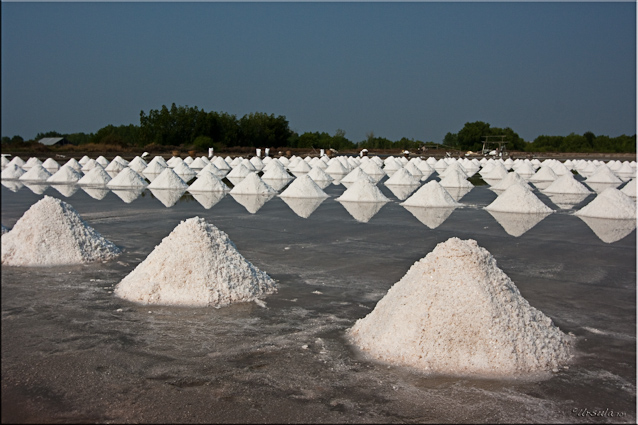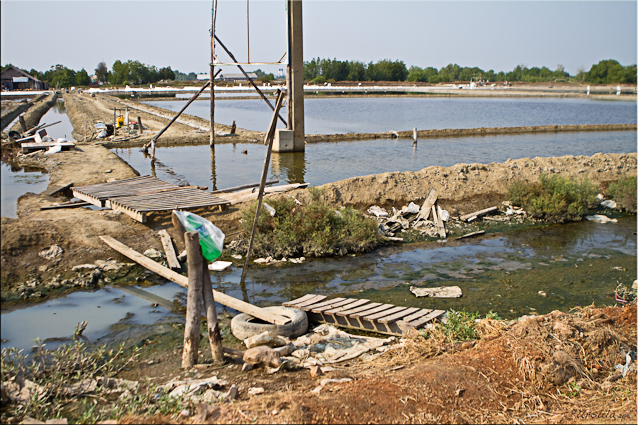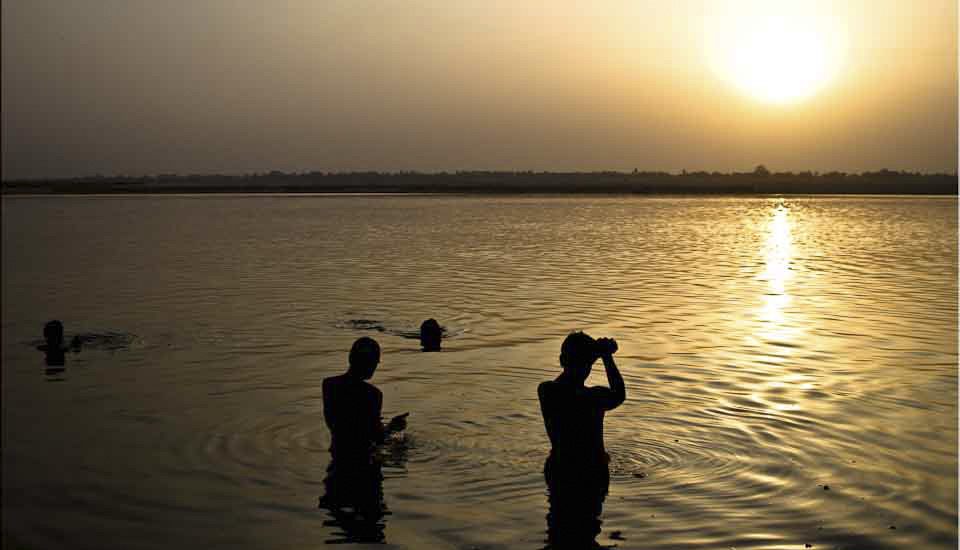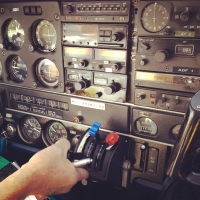Have you ever wondered where your salt comes from? No – I haven’t either! Salt is one of those many things we tend to take for granted.

Salt Pans, Samut Sakhon
In Thailand, most of the salt used comes from brine salt-farms, and the largest number of these brine salt farms are close to Bangkok, along Highway 35 in Samut Sakhorn. We’ve driven past these large square fields that resemble rice patties – except for the obvious absence of rice – many times, and I’ve often commented that they’d be worth photographing, but we’ve always been in a hurry to get somewhere else. This week, driving home from the delightful beach town of Hua Hin, we stopped for coffee at a petrol station right next to one of the many salt farms. Well, the temptation was irresistible and I wandered into one of the all-but-vacant lots.

Entry to the Salt Pans: Planks and Steps off the Highway

Wooden Roller

Rolling Machine at the Salt Pans

Equipment and People at Rest

Briny Wicker Basket

Like the Outdoor Ice-Rinks of my Childhood!

Tropical Zamboni?
It wasn’t long before people came out to chat to us. I did my best to ask intelligent questions about the salt pans: “How long does it take to produce the salt?” “One month.” “This one,” I asked, pointing to the piles of salt, beautifully dotted around the paddock. “Ready,” I was told. “This one?” I indicated the the smooth surface with the wooden rake lying in it. “ยัง – Not yet,” was the answer. That just about exhausted my Thai for the day, so we had to satisfy ourselves with smiling a lot. My companion looked at his watch: “Three-thirty!” he exclaimed, as if that was important.
Sure enough, as if by magic, people appeared from everywhere and the salt pan which was ready became a hive of activity: men and women in socks, boots or bare feet, walked out to the piles and set to work. For the most part, the women shovelled the salt into bamboo carry-baskets, and the men, balancing a basket at each end of a long carry pole, carried the salt back to the store room.
To make the salt, the prepared fields are flooded with sea water pumped in from the near-by Gulf of Thailand, dammed, and left to dry naturally in the sun. When the water has evaporated, the salt is piled and taken away to be cleaned and bagged for sale: on the roadside, in local shops and internationally. According to a web-blog source (and I could find no other reliable data), Thailand produces a million tonnes of salt each year. From what I saw, each pound is labour intensive!

Working in Concert

Moving Baskets

A Moment’s Pause

That Thai Smile is Never Far Away!

Working the Salt Fields

Elders Continue Working…

Raking Piles into Baskets

Salt Foot Scrub?

Levelling the Salt with Nonchalance

Socks in the Salt

Salty Reflections

Keeping the Salt Farms Tidy

Somehow, Spilt Salt Seems More Serious when You See How Much Work Goes into Each Bag!

Buy it From the Source! Salt and Salted Fish (ปลาสลิด) for Sale. The Woman is Waving her Hand to Ask Passers-By to Stop, While her Dog Sleeps in the Shade.
Food for thought when you next salt your eggs! Happy Travels.

























.png)


Wonderful pictures Ursula, thanks for sharing!
Hi guys,
you are so right… we take salt for granted, I don’t ever recall wondering how we got it etc… makes my addiction even more profound lol
Hi Ursula many thanks for the link to my photoblog. The stats came from a Bangkok Post article and Wikipedia, as you say they are difficult to come by.
I have relatives in Samut Sakhon, so I usually stop near the farms if we are visiting.
BTW did you know that production ceases during the rainy season(probably obvious why)?
You have a very nice blog and I think the photos are great.
Best wishes
Mike
Hi Mike! You obviously had more luck with Wiki than I did. I tried the Bangkok Post link, and they sent me to the front page. I thought your page was great – and daily!! My gosh, weekly is killing me! 😉 Oh well. And, yes, I know all about rainy season! 🙂
Greetings Cathy and Signe! Nice to see you both. 🙂
Hello Ursula, a wonderful set and comments. I travelled along this road from Hua Hin last year but I do not remember seeing the salt fields. But now I have seen these photos I may try and visit this area when I next visit Krung Thep.
All the best
Paul.
Thanks for visiting, Paul!
We’ve driven past so many times – always in a hurry to somewhere else! This visit we were lucky – we stopped mid afternoon on our way back to Bangkok and wandered into the salt pans while it was quiet… not a soul around… Within half an hour, the place came to life, and everyone set to work! The workers were mostly happy to have me hanging around, which was nice. 🙂
I was vacationing in thailand in january. I did see these salt fields on are way from Hua Hin to Pattaya. They were very interesting……
Hi Janice,
Thanks for the vist! Thailand is full of interesting sights! 🙂
[…] Para conocer más acerca de la recolección de la sal marina visitar el fotoblog: Sal de Samut Sakhon, Tailandia https://www.ursulasweeklywanders.com/travel/salt-samut-sakhon-thailand/ (Inglés). […]
Dear Sir ,
I would like to know this salt manufacture company as I ‘m interested to buy direct form them . Contact No 0832933838 Khun Tan
Thank You .
Sincerely
Khun Tan
Dear Kh Tan,
I’m afraid I have no idea how to find the companies involved! Good luck with your search.
Hello Ursula, for a long time I have been dealing with salt ponds or the production of white gold by solar evaporation. Now I found these beautiful shots of the salt mountains and the people doing their hard work on the salt fields. This impresses me a lot and also your photos, which captured everything. I send you best regards from autumn Germany and wish you a lot of fun with your photo projects.
Hans-Joachim Engelhardt
Hi Hans-Joachim!
Thanks for your lovely greeting. I’m so sorry to be so slow in replying: I have been travelling in lands with no internet. Enjoy your autumn!
Read the book “Salt”. It’s very interesting on the subject we all probably take from granted.
It is a fascinating subject, Tallwahl. 😀
Just passby on our drive to Chumphon..
Bought 1 packet as the lady mentioned is non ionised salt
. 7